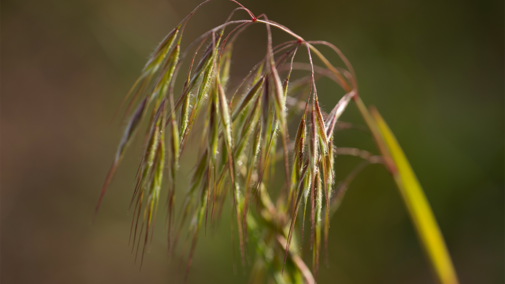Controlling Winter Annual Bromes
Was cheatgrass, sometimes called downy brome, or wild oats abundant in your pastures this spring? Although difficult, they can be controlled and your pasture revitalized.
Winter annual bromes often invade thin or overgrazed pastures in fall and early spring. Livestock dislike grazing them after they become mature and over time, they can take over and make large patches in a pasture.
Research by the University of Nebraska evaluated herbicides for controlling cheatgrass. Products containing rimsulfuron and imazapic (Plateau®) can provide good control of cheatgrass from a single application, but control can vary widely from year to year depending on when the application is made, maturity of cheatgrass plants and the weather patterns. A one-time management operation, utilizing grazing, mowing or a non-residual herbicide like rimsulfuron or imazapic, usually does not have a lasting impact on the cheatgrass in the seedbank. To reduce the seedbank, control needs to be close to 100% and repeated over several years.
Rejuvra™ is a new rangeland herbicide product from Bayer that works differently from existing cheatgrass herbicides. Rejuvra™ has limited activity on emerged plants and only controls seedlings as they germinate, so it is best to apply Rejuvra™ in early fall before seeds germinate. This herbicide can provide control up to two years post-application.
For warm-season grass pastures, there is another option. You can use glyphosate herbicides after top growth of these grasses has gone dormant due to a hard freeze or two. This can kill emerged annual brome seedlings or other cool-season species without harming the desirable grasses. With any herbicide, always read and follow label directions.
With these herbicide options and proper grazing management, your pastures can develop thicker stands of the more desirable grasses.
Timing Last Alfalfa Harvest with GDD
Allowing for alfalfa to winterize before dormancy is a key factor preventing winter kill across a stand. Traditionally, my recommendation has been to time the last cutting for roughly six weeks before the first frost.
While this general guideline has proven its worth over the years, many producers would love to have a bit more accurate method to time last cuttings. One way to narrow the no-harvest window down is by utilizing growing degree days (GDD). Work from Dr. Dan Undersander with the University of Wisconsin calculated winterkill risk looking at GDDs at a base 41°F accumulating until a killing frost of 24°F. The two GDD levels of importance for alfalfa stands were 500 and 200.
By providing at least 500 base 41°F GDD after harvest, research trials showed that there was sufficient time for alfalfa to winterize. If harvest occurred with under 200 GDD left, alfalfa plants did now have sufficient time to regrow and deplete carbohydrate reserves to a level that would negatively impact winterization.
While other factors like ground cover and stress of the stand over the course of the year need to factor into the decision for a late cutting, this gives us a more accurate calendar point to shoot for if forage is needed. We also need to keep in mind that late cuttings may have a difficult time drying down in a timely fashion.
Most of the state is right at the edge of our 500 GDD threshold. To decide where you stand, the High Plains RCC CLIMOD can be used to look at past years GDD. Using accumulated 41 GDD for past years and your expected first freeze dates, we can avoid the 500-200 GDD no harvest zone and plan a late alfalfa cutting if needed.
Fall Armyworm Awareness
In previous years, portions of eastern Nebraska have seen unprecedented numbers of fall armyworm caterpillars feeding on alfalfa, brome regrowth in pastures, and newly seeded small grain crops such as wheat, triticale and rye. While reports of armyworm damage have not been received so far this year, it is a good idea to keep an eye out for this insect.
Fall armyworm caterpillars can be distinguished from other Lepidopterans by markings on the head that resemble an inverted “Y” and four spots on the last abdominal segment that form a square. This insect does not overwinter in Nebraska but rather migrates north from southern states when populations build up in late summer. Once caterpillars are ¾-inch, they can do considerable damage in a few days. Because of this, it is important to scout fields and pastures in the early morning and late afternoon — when caterpillars are most active — to spot them when they are small.
A reasonable treatment threshold is finding three or more caterpillars per square foot within a field or pasture. There are several insecticides labeled to control this insect including Mustang Maxx, Besiege and Sevin. For forage crops, be sure to check the grazing restriction and post-harvest interval. When considering a chemical treatment option, keep in mind caterpillars ¾-inch or longer are close to maturity and can be harder to control with an insecticide.
Fall armyworm feeding declines with cooler temperatures and the adult moths eventually migrate south. In the meantime, be sure to keep an eye on your pastures and newly seeded fields for any sign of infestation.

